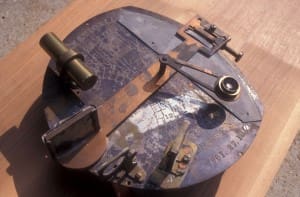
If you were stranded on a small atoll and needed a sextant for your rescue voyage, you’d have no choice but to make one. Most of us would probably do little better than a rough instrument made from sticks and of doubtful accuracy. In this very situation, however, a shipwrecked ship’s engineer in 1870 made a sextant of astounding quality that helped guide rescuers to save 83 men.
The wreck was of the sidewheel steam sloop-of-war USS Saginaw on Kure Atoll in the Pacific. The wreck occurred 150 years ago last October. After salvaging material and tools from the wreck, the crew from Saginaw, half USN personnel and half civilian contractors, set up camp and awaited rescue. With fresh water and supplies starting to run low, however, the survivors realized that they must send a party in one of Saginaw’ssmall boats, the captain’s gig, more than 1,000 miles east across the Pacific to Hawaii to prompt a rescue effort.
One of the items the rescue party would need aboard the gig was an instrument for navigation. At least one of Saginaw’s sextants was saved intact from the wreck, but that instrument would not go with the gig crew. The survivors were engaged in building a schooner from salvaged timbers that they would use if the small boat effort failed. So it was decided that the ship’s one good sextant would stay on the island.
Saginaw’s assistant engineer Herschel Main, an 1868 graduate of the U.S. Naval Academy, took on the task of building a new sextant from a few pieces salvaged from another of the ship’s sextants and whatever else he could use from the wreck. Main performed his role masterfully, as frequent ON contributor Steve D’Antonio writes in a 1999 article on the Saginaw episode published in Nautical World magazine: “Main ‘manufactured’ a sextant with little more than a cold chisel, hammer, a couple of small taps, four or five half-worn and ill-adapted files, a pocketknife, a drill-brace and some pieces of steel wire. He fashioned the main face of the sextant from the dial of a steam vacuum gauge and hammered the [index] arm from a copper bolt pulled from the Saginaw’s timbers. Main made the scale from a piece of sheet zinc flattened and rubbed off with charcoal. He cut the vernier [scale] into the zinc with a pocketknife, copying it from the original ship’s sextant. This sextant, accurate to one minute of arc, served as a remarkable example of a bit of ingenuity and a good engineering education.”
Ultimately, after a 1,400-mile, 28-day voyage, the gig reached Hawaii. Only one of the five men aboard the gig, Coxswain William Halford, survived the journey. He succeeded in getting word to authorities and arranging for the rescue of his 83 Saginaw shipmates, which was successful in January 1871. The sextant survived and is displayed at the museum at the Naval Academy in Annapolis.

